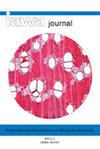Seasonal temperature and precipitation regimes drive variation in the wood of oak species (Quercus) along a climatic gradient in western Mexico
IF 3.5
3区 农林科学
Q2 FORESTRY
引用次数: 3
Abstract
To achieve optimal balance among wood’s support, storage, and transport functions, tree species present adaptive variation in wood anatomical traits. Oaks (Quercus) are woody plants that are dominant in many ecosystems, possess wide variation in wood traits, and can tolerate water stress in diverse habitats. Mountain regions contain steep climatic gradients that exert strong environmental pressures on wood traits. The aims of this study were: (1) to quantify the anatomical variation in 21 oak species distributed along an environmental gradient and (2) to analyze the interspecific variation among the studied species. Fibres and parenchyma fractions were the most abundant cell types. We found a trade-off between total fibre fraction and total parenchyma fraction modulated by the precipitation during the warmest quarter in which oak species in drier areas invested more in support cells. The 21 oak species studied showed vasicentric tracheids, which could be essential to compensate for the transport system in drier areas. Wood density was negatively correlated with the axial parenchyma fraction and fibre lumen width. Oak species have high interspecific variation in the total vessel fraction and vessel diameter. Anatomical variation in oak species along a climatic gradient showed a broad continuum of fibre characteristics from wide to narrow wall and lumen, abundant to scarce parenchyma, and wide to narrow vessels. These variations imply a diversification of ecological strategies within the genus that includes the vascular design of the stem to define the tolerance and competitiveness of the oak species.在墨西哥西部,季节性的温度和降水制度驱动了沿气候梯度变化的橡树树种(栎)的木材
为了在木材的支撑、储存和运输功能之间达到最佳平衡,树种在木材解剖性状上表现出适应性变异。橡树(栎)是木本植物,在许多生态系统中占主导地位,具有广泛的木材性状变异,并能在不同的生境中耐受水分胁迫。山区具有陡峭的气候梯度,对木材性状施加了强大的环境压力。本研究的目的是:(1)定量分析21种栎树沿环境梯度分布的解剖变异;(2)分析所研究树种间的种间变异。纤维和薄壁组织是最丰富的细胞类型。我们发现,在最温暖的季节,总纤维分数和总薄壁组织分数之间存在着一种权衡,在这种权衡中,干燥地区的橡树树种在支持细胞上的投入更多。所研究的21种橡树显示出维管心管胞,这可能是补偿干旱地区运输系统所必需的。木材密度与轴向薄壁组织分数和纤维腔宽呈负相关。栎树种间在总导管分数和导管直径上有较大的变异。在不同的气候梯度下,橡木的解剖结构表现出从宽到窄的壁和管腔、从丰富到缺乏的薄壁和从宽到窄的血管的纤维特征的广泛连续体。这些变化暗示了属内生态策略的多样化,包括茎的维管设计,以确定橡树物种的耐受性和竞争力。
本文章由计算机程序翻译,如有差异,请以英文原文为准。
求助全文
约1分钟内获得全文
求助全文
来源期刊

IAWA Journal
农林科学-林学
CiteScore
3.40
自引率
15.80%
发文量
26
审稿时长
>36 weeks
期刊介绍:
The IAWA Journal is the only international periodical fully devoted to structure, function, identification and utilisation of wood and bark in trees, shrubs, lianas, palms, bamboo and herbs. Many papers are of a multidisciplinary nature, linking
 求助内容:
求助内容: 应助结果提醒方式:
应助结果提醒方式:


